2. What should I know before I use CUVITRU?
Do not use CUVITRU if you have severe immunoglobulin A (IgA) deficiency and history
of hypersensitivity to human immunoglobulin treatment. Do not use if you have ever
had an allergic reaction to CUVITRU or any of the ingredients listed at the end of
the CMI.
Talk to your doctor if you have any other medical conditions, take any other medicines,
or are pregnant or plan to become pregnant or are breastfeeding.
For more information, see Section
2. What should I know before I use CUVITRU? in the full CMI.
3. What if I am taking other medicines?
4. How do I use CUVITRU?
The recommended dose and schedule will be established by your doctor. Your doctor
may adjust the dose based on your response to the treatment.
CUVITRU must be infused under the skin by either using an infusion pump or manual
administration using a syringe. Your doctor will determine the appropriate infusion
technique and the infusion rate for you taking into account your individual dose,
dosing frequency and product tolerability. More instructions can be found in Section
4. How do I use CUVITRU? in the full CMI. If your doctor considers that you should receive CUVITRU at home,
they will ensure you receive detailed instructions and training on how to use it.
5. What should I know while using CUVITRU?
|
Things you should do
|
Remind any doctor, dentist, or pharmacist you visit that you are using CUVITRU
Call your doctor straight away, if you experience any allergic symptoms (skin rash,
itching, chest tightness, wheezing, dizziness, hives, faintness, chills, flushing,
rapid heartbeat, shortness of breath and/or a swollen face).
|
|
Things you should not do
|
Do not stop using your medicine or alter the dosage, without checking with your doctor,
unless you have an allergic reaction
|
|
Driving or using machines
|
Be careful before you drive or use any machines or tools until you know how CUVITRU
affects you.
|
|
Looking after your medicine
|
Keep CUVITRU in the fridge where the temperature is between 2°C - 8°C. Do not freeze.
|
6. Are there any side effects?
All medicines can have side effects. If you do experience any side effects, most of
them are minor and temporary. However, some side effects may need medical attention.
If you experience sudden signs of allergy such as swelling of the lips, tongue, or
eyes, loss of consciousness, hives, difficulty in breathing, call your doctor straight
away, or go straight to the Emergency Department at your nearest hospital. For more
information, including what to do if you have any side effects, see Section
6. Are there any side effects? in the full CMI.
Active ingredient(s):
Normal Immunoglobulin infusion 20% (Human)
Full Consumer Medicine Information (CMI)
This leaflet provides important information about using CUVITRU. You should also speak to your doctor or pharmacist if you would like further information
or if you have any concerns or questions about using CUVITRU.
Where to find information in this leaflet:
1. Why am I using CUVITRU?
CUVITRU is an immunoglobulin solution for subcutaneous infusion.
CUVITRU contains the active ingredient human immunoglobulin.
Immunoglobulins are also known as antibodies and are found in healthy people's blood.
Antibodies are part of the immune system (the body's natural defenses) and help your
body to fight infections. If you do not have enough antibodies, you may not be able
to fight off infections.
CUVITRU is used in patients who do not have enough antibodies in their blood. CUVITRU can be used as antibody replacement therapy to raise antibody levels in your
blood to normal levels.
Your doctor may have prescribed CUVITRU for another reason.
2. What should I know before I use CUVITRU?
About blood products
When medicines are made from human blood or plasma, processes are used to prevent
infections from being passed from the blood/plasma donor to the person receiving the
medicine.
These processes include careful selection of the people who donate blood and plasma
to make sure that those who might be carrying infections are excluded. In addition,
each donation and pools of donations are tested for indicators of virus or virus infection(s).
Manufacturers of these medicines also include steps in the processing of blood or
plasma that inactivate or remove viruses. A three-step viral inactivation/reduction
has been applied during the manufacturing of the normal immunoglobulin infusion.
Despite the stringent measures which have been put in place during the manufacturing
processes, the risk of contamination by viral and other unknown agents cannot be totally
excluded.
The measures taken during manufacturing are considered effective for enveloped viruses
such as human immunodeficiency virus (HIV), hepatitis B virus and hepatitis C virus,
and for the non-enveloped viruses hepatitis A (HAV) and B19 virus (B19V).
Immunoglobulins have not been associated with hepatitis A or parvovirus B19 infections
possibly because the antibodies against these infections, which are contained in the
product, are protective.
Warnings
Do not use CUVITRU if:
you have known history of allergic or severe hypersensitivity reactions to the subcutaneous
administration to immunoglobulins, or any of the ingredients listed at the end of
this leaflet (see Product details)
you have severe immunoglobulin A (IgA) deficiency and history of hypersensitivity
to human immunoglobulin treatment.
Check with your doctor if you:
have antibodies against immunoglobulin A in your blood. This may occur if you have
IgA deficiency
have allergies to any other medicines, or if you ever had an allergic reaction to
an injection
take any medicines for any other condition
have pre-existing factors for thrombotic events or that increase the risk of renal
complications
have or have had any medical problems
During treatment, you may be at risk of developing certain side effects. It is important
you understand these risks and how to monitor them. See additional information under
Section
6. Are there any side effects?
Pregnancy and breastfeeding
Check with your doctor if you are pregnant or intend to become pregnant.
Talk to your doctor if you are breastfeeding or intend to breastfeed.
3. What if I am taking other medicines?
Tell your doctor if you
have had a vaccination recently
if you are taking any other medicines, including any medicines, vitamins, or supplements
that you buy without a prescription from your pharmacy, supermarket, or health food
shop.
Check with your doctor or pharmacist if you are not sure about what medicines, vitamins
or supplements you are taking and if these affect CUVITRU.
4. How do I use CUVITRU?
How much to use
Always use CUVITRU exactly as your doctor has told you. Check with your doctor if
you are not sure
Follow the instructions provided and use CUVITRU until your doctor tells you to stop.
When to take CUVITRU
Ensure you are adequately hydrated before the administration of CUVITRU.
How to use CUVITRU
CUVITRU must be infused under the skin
Your doctor or healthcare professional will first infuse CUVITRU slowly and monitor
you throughout the first infusions so that any allergic reaction can be detected and
treated immediately.
Treatment with CUVITRU will be started by your doctor or healthcare professional,
but you may be allowed to use the medicine at home (e.g., by using an infusion pump
or manual administration using a syringe) once you have received the first few infusions
under medical supervision and you (and/or your guardian) have been adequately trained
You and your doctor will decide if you can use CUVITRU at home
Do not begin treatment with CUVITRU at home until you have received complete instructions
Always wash your hands before using CUVITRU. Use germ-free methods during the making up procedure and during injection
CUVITRU is for single use in one patient only.
When using manual administration:
CUVITRU may be administered using a syringe at a single infusion site. If administration
at additional sites is required, a new sterile injection needle should be used
The amount of product infused into a single site varies and doses over 30 mL may be
divided according to your preference
Consult with your doctor. Start with an infusion speed that does not cause discomfort.
At no time should the infusion be painful. The recommended infusion rate is approximately
1-2 mL per minute. You may find that some injection sites will tolerate larger volumes
of infusion than others.
If you miss/forget your injection
Do not infuse a double dose of CUVITRU to make up for a missed dose. If you think
that you have missed a dose, speak to your doctor as soon as possible.
If you use too much CUVITRU (overdose)
The effects of an overdose of CUVITRU are not known.
You should immediately:
phone the Poisons Information Centre
(by calling
13 11 26), or
contact your doctor, or
go to the Emergency Department at your nearest hospital.
You should do this even if there are no signs of discomfort or poisoning.
5. What should I know while using CUVITRU?
Things you should do
Call your doctor straight away if you:
experience allergic reactions such as skin rash, itching, chest tightness, wheezing,
dizziness, hives, faintness, chills, flushing, rapid heartbeat, shortness of breath
and/or a swollen face.
Remind any doctor, dentist, or pharmacist who are treating you, that you are using
CUVITRU.
If you are about to start on any new medicine, tell your doctor or pharmacist that
you are taking CUVITRU.
Talk to your healthcare provider before travelling. Plan to bring enough medicine
for your treatment during this time. It is important to obtain a written statement
from your physician, explaining the reasons why you need to have this medicine and
injecting devices with you, otherwise you may not be allowed to bring it into the
country of travelling.
Things you should not do
Do not give your medicine to anyone else, even if they have the same condition as
you
Do not use your medicine to treat any other complaints unless your doctor tells you
to
Do not stop using your medicine or lower the dosage, without checking with your doctor,
unless you have an allergic reaction.
Driving or using machines
Be careful before you drive or use any machines or tools until you know how CUVITRU
affects you.
Looking after your medicine
CUVITRU should be stored in the refrigerator at 2°C to 8°C.
Do not freeze
Store in the original package to protect from light
Keep it where young children cannot reach it.
When to discard your medicine
CUVITRU contains no preservatives.
Discard any medicine left in the vials at the end of your infusion.
Dispose off all materials, including any leftover reconstituted medicine, in an appropriate
container.
Getting rid of any unwanted medicine
Medicines should not be disposed of via wastewater or household waste. Ask your pharmacist
how to dispose of the medicines no longer required.
Do not use CUVITRU after the expiry date which is printed on the label after the word
'EXP'. The expiry date refers to the last day of that month.
6. Are there any side effects?
All medicines can have side effects. If you do experience any side effects, most of
them are minor and temporary. However, some side effects may need medical attention.
See the information below and, if you need to, ask your doctor or pharmacist if you
have any further questions about side effects.
Less serious side effects
|
Less serious side effects
|
What to do
|
|
Swelling, pain, redness or itching where the injection was given
Headache/migraine
Nausea or vomiting
Pain (including pain in the chest, back, joints, arms, legs)
Muscle pain
Fatigue
Diarrhoea
Stomach ache or bloating
Cough
Fever of chills
Feeling faint, dizzy, or lightheaded (fall in blood pressure)
Infusion site ulcer.
|
Speak to your doctor if you have any of these less serious side effects and they worry
you.
Certain side effects, such as headache, chills, or body aches, may be reduced by slowing
the infusion rate.
|
Serious side effects
|
Serious side effects
|
What to do
|
|
Reduced urination
Severe headache
Neck stiffness
Inability to stand bright light
Painful eye movements
Pain/tenderness, swelling/discolouration of an arm or leg
Tingling, numbness, or weakness on one side of the body
Shortness of breath
Chest pain
Fever
Allergic or anaphylactic reaction; symptoms of which may include - swelling of the
lips, tongue, or eyes, loss of consciousness, hives, difficulty in breathing.
Non-bacterial (viral) infection of the tissues covering brain and spinal cord (aseptic
meningitis)
|
Call your doctor straight away or go straight to the Emergency Department at your
nearest hospital if you notice any of these serious side effects.
|
Tell your doctor or healthcare professional if you notice anything else that may be
making you feel unwell.
Other side effects not listed here may occur in some people.
Reporting side effects
After you have received medical advice for any side effects you experience, you can
report side effects to the Therapeutic Goods Administration online at
www.tga.gov.au/reporting-problems . By reporting side effects, you can help provide more information on the safety of
this medicine.
Always make sure you speak to your doctor or pharmacist before you decide to stop
taking any of your medicines.
7. Product details
This medicine is only available with a doctor's prescription.
What CUVITRU contains
|
Active ingredient
|
20% plasma proteins of which at least 98% are immunoglobulins.
|
|
Other ingredients
|
Glycine and water for injections
|
|
Potential allergens
|
Trace amounts of IgA
(≤ 280 mcg/mL)
|
Do not take this medicine if you are allergic to any of these ingredients.
What CUVITRU looks like
CUVITRU (ARTG 282579) is a clear and colourless to pale yellow or light brown solution
in a glass vial.
CUVITRU is available in the following pack sizes:
1 g in 5 mL
2 g in 10 mL
4 g in 20 mL
8 g in 40 mL
10g in 50 mL.
Not all pack sizes may be marketed.
Who distributes CUVITRU
CUVITRU is distributed in Australia by:
Takeda Pharmaceuticals Australia Pty Ltd
Level 39; 225 George Street
Sydney NSW 2000
Australia
Phone: 1800 012 612
This leaflet was prepared in July 2025.
8. How to use CUVITRU - Instructions for use
If you do not understand the instructions, ask your doctor or healthcare professional.
Always follow the specific instructions given by your healthcare provider. The steps
listed below are general guidelines for using your medicine.
Prepare CUVITRU vial(s)
Remove CUVITRU from the box. Allow vials to reach room temperature. This may take
up to 90 minutes
Do not apply heat or place in microwave
Do not shake the vial(s).
Do not use beyond the expiration date
Do not use, if the protective cap is missing or broken
Look at the colour of the solution in the vial. It should be clear and colourless
to pale yellow or light brown
Do not use if the solution is cloudy or has particles.
The supplies include vial(s) of CUVITRU, infusion supplies, subcutaneous needle set,
transfer device(s), syringe(s), sterile tip caps, sterile clear bandage, tape, gauze,
sharps container, infusion pump (if using), tubing, infusion log.
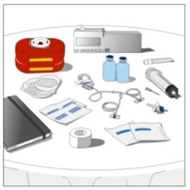
Clean work area
When using an infusion pump:
Program the infusion pump according to prescribed infusion rates and manufacturer's
instructions
Wash hands thoroughly and allowed to dry.
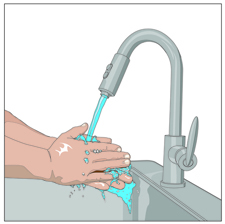
Open supplies as shown by your healthcare professional.
3.
Prepare the syringe(s)
Remove the cap from the vial.
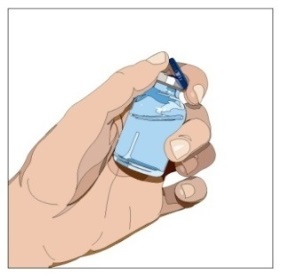
Wipe each stopper with a sterile alcohol wipe and allow to dry.
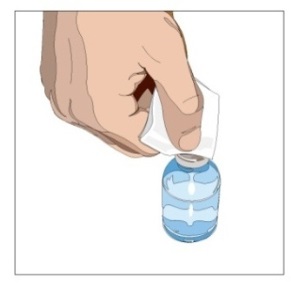
Attach a sterile syringe to a vented spike
Insert the vented spike into the centre of the CUVITRU vial.
Turn the vial upside down and pull back on the plunger to pull back on the plunger
to pull the solution into the syringe(s).
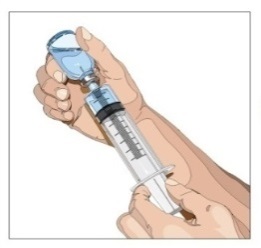
Repeat the steps, if using multiple vials to achieve the desired dose.
Start the infusion promptly after drawing CUVITRU into the syringe(s). It is suggested
to complete the administration within 2 hours.
If using a sterile needle:
Attach a sterile syringe to the sterile needle and pull back the plunger of syringe
to fill with air which should equal the amount of the solution you will be taking
from the vial.
Insert the needle into the centre of the stopper, and inject air in. Pull back on
the plunger to withdraw the desired volume.
4.
Prepare for the infusion
a. When using an infusion pump:
Use manufacturer directions for filling the tubing and using the pump.
Attach the syringe filled with CUVITRU to the needle set.
Point the syringe tip up and gently push the plunger of the syringe to remove the
air and fill the needle set up to the needle hub.
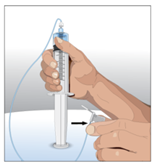
b. When using manual administration:
Follow the instructions by your nurse or healthcare professional.
Attach the syringe filled with solution to the needle set
Point the syringe tip up and gently push the plunger of the syringe to remove the
air and fill the needle set up to the needle hub.
5.
Prepare the infusion site(s):
Select the number of infusion sites based on the volume of the total dose.
Choose infusion site(s): upper arms, abdomen, thighs, or lower back.
Avoid bony areas, visible blood vessels, scars, and any areas of inflammation (irritation)
or infection.
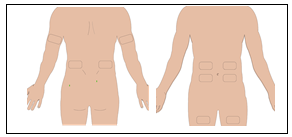
Infuse CUVITRU from 1 to 4 infusion sites at the same time. Select sites at least
4 inches apart.
Rotate sites between future infusions
Wipe the infusion site(s) with a sterile alcohol wipe beginning at the centre of each
infusion site and moving outward in circular motion. Allow the infusion site(s) to
dry (at least 30 seconds).
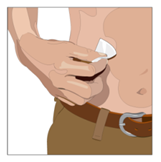
6.
Insert and secure the subcutaneous needle set:
Remove the needle cover. Firmly grasp and pinch at least 1 inch of skin between two
fingers.
Insert needle with a rapid motion straight into the skin at a 90-degree angle. Tape
needle in place with sterile tape (included on transparent dressing).
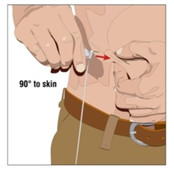
If more than one site is used, repeat the steps
Check for proper needle placement by pulling back on the syringe plunger to check
for blood return in the tubing of the needle set.
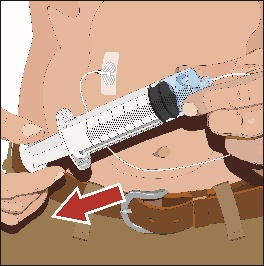
If blood is seen in the tubing, remove and discard the subcutaneous needle and repeat
steps 4, 5 and 6 with a new subcutaneous needle and infusion site.
Secure the needle set in place by applying a sterile protective dressing over the
site(s).
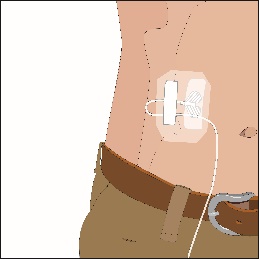
When infusing by pump:
Follow the manufacturer’s instructions to turn pump on and start the infusion
When infusing manually:
Gradually press on the plunger of the syringe as shown by your doctor or nurse, until
all fluid in the syringe has been injected, or as explained by your doctor or nurse.
Check infusion site(s) occasionally throughout the infusion.
8.
Remove subcutaneous needle(s) from the infusion site(s):
Remove the needle set by loosening the tape on all edges.
Pull the needle wings straight up and out
Gently press a small piece of gauze over the needle site and cover with a dressing.
Throw away the needle(s) into the sharps container.
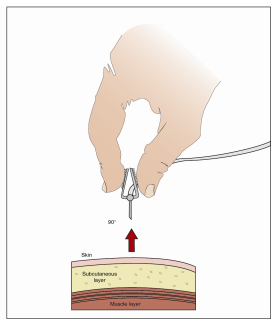
Remove the peel-off label from the vial(s), which has the product lot number and expiration
date, and place the label in your treatment record/infusion log.
Write down the date, time, dose, site(s) of infusion (to assist in rotating sites)
and any reactions after each infusion.
Throw away the disposable supplies, vials, and unused product as recommended by your
healthcare professional.
CUVITRU
®
is a trademark of Baxalta Incorporated. TAKEDA
®
and the TAKEDA logo
®
are registered trademarks of Takeda Pharmaceutical Company Limited.